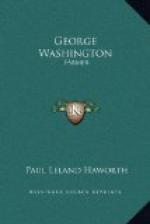Whether they came to America of their own free will or not such servants were subjected to stringent regulations and were compelled to complete their terms of service. If they ran away, they could be pursued and brought back by force, and the papers of the day were full of advertisements for such absconders. Owing to their color and the ease with which they found sympathizers among the white population, however, the runaways often managed to make good their escape.
To give a complete list of Washington’s indentured servants, even if it were possible, would be tedious and tiresome. For the most part he bought them in order to obtain skilled workmen. Thus in 1760 we find him writing to a Doctor Ross, of Philadelphia, to purchase for him a joiner, a brick-layer and a gardener, if any ship with servants was in port. As late as 1786 he bought the time of a Dutchman named Overdursh, who was a ditcher and mower, and of his wife, a spinner, washer and milker; also their daughter. The same year he “received from on board the Brig Anna, from Ireland, two servant men for whom I agreed yesterday—viz—Thomas Ryan, a shoemaker, and Cavan Bowen a Tayler Redemptioners for 3 years service by Indenture.” These cost him twelve pounds each. The story of his purchase of servants for his western lands is told in another place, as is also that of his plan to import Palatines for the same purpose.
On the day of Lexington and Concord, but before the news of that conflict reached Virginia, two of his indentured servants ran away and he published a lengthy advertisement of them in the Virginia Gazette, offering a reward of forty dollars for the return of both or twenty dollars for the return of either. They were described as follows:
“THOMAS SPEARS, a joiner, born in Bristol, about 20 years of age, 5 feet 6 inches and a half high, slender made. He has light grey or blueish colored eyes, a little pock-marked, and freckled, with sandy colored hair, cut short; his voice is coarse, and somewhat drawling. He took with him a coat, waistcoat, and breeches, of light brown duffil, with black horn buttons, a light colored cloth waistcoat, old leather breeches, check and oznabrig shirts, a pair of old ribbed ditto, new oznabrig trowsers, and a felt hat, not much the worse for wear. WILLIAM WEBSTER, a brick maker, born in Scotland, and talks pretty broad. He is about 5 feet six inches high and well made, rather turned of 30, with light brown hair, and roundish face.... They went off in a small yawl, with turpentine sides and bottom, the inside painted with a mixture of tar and red lead.”
In the course of his business career Washington also employed a considerable number of free white men, who likewise were usually skilled workers or overseers. He commonly engaged them for the term of one year and by written contracts, which he drew up himself, a thing he had learned to do when a boy by copying legal forms. Many of these papers still survive and contracts with joiners and gardeners jostle inaugural addresses and opinions of cabinet meetings.




